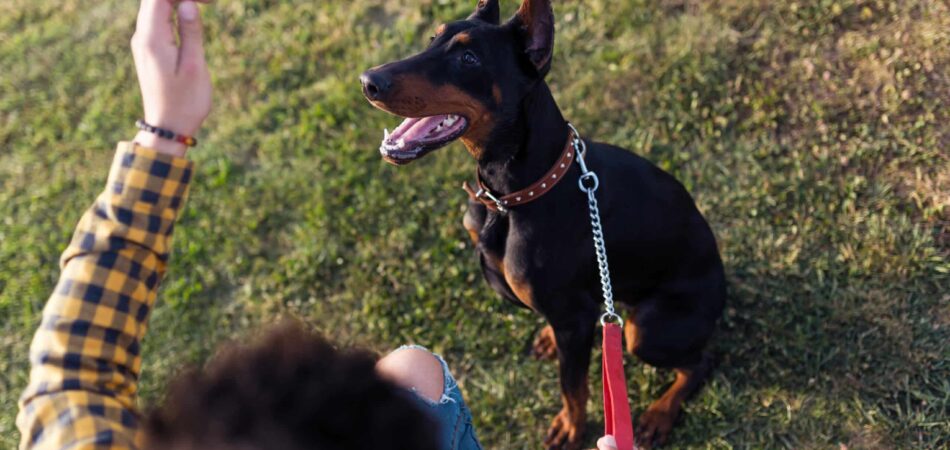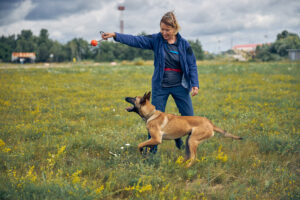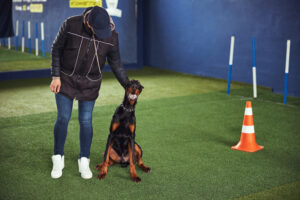






No one bats an eye when an otherwise lazy lab is asked to attack as or a border is asked to sit. We recognize that these are typical commands of the breeds.
So why are people running out and getting high-drive protection dogs without first understanding the commands of these dogs?
To put it bluntly, protection dogs are bred to stay loyal and that’s what they do. They are bred to bite and do serious damage to bad guys. This is what they think about. This is what they know.
Owning a protection dog is a big responsibility. These dogs require extensive training and socialization to ensure they can be safe and reliable companions.
Their intense guarding instincts and protective nature mean that without the right training, they can be a danger to both people and other animals.
That’s why it’s so important for every protection dog owner to have a solid grasp of the essential commands their dog needs to know.
With Vanguard Protection Dogs, you’ll have the support and guidance needed to create a well-trained, loyal protector. Contact us today to learn more about how we can help you train a reliable and trustworthy companion!
 The most basic and crucial command for any dog is the “sit” and “stay” commands. This allows you to control your dog’s movements and keep them in a safe, stationary position when needed.
The most basic and crucial command for any dog is the “sit” and “stay” commands. This allows you to control your dog’s movements and keep them in a safe, stationary position when needed.
With protection dogs, the “sit/stay” is especially important for keeping them calm and under control in public settings or around strangers.
You need to be able to quickly and reliably get your dog to sit and stay on command, no matter the distractions or triggers around them.
Building on the “sit/stay”, the “down/stay” command is another foundational skill for protection dogs. Being able to get your dog to lie down and hold that position is essential for keeping them under control in high-stress situations.
The “down/stay” can be used to de-escalate a guarding or protective response, and it’s a critical safety command if you ever need to make your dog lie flat and remain motionless.
The “come” command may be the most important safety skill you can teach a protection dog.
Being able to reliably call your dog back to you, even when they are in full protection mode, could be the difference between a safe outcome and a disaster.
Thorough recall training is a must, as you need to be able to override your dog’s natural instinct to defend and instead bring them back to you on command.
The “watch” or “watch me” command is a way to focus your dog’s attention solely on you, even in the midst of external triggers or distractions.
This is vital for maintaining control and keeping your protection dog’s focus when they might otherwise be provoked into a protective response.
Being able to instantly command your dog’s attention can defuse tense situations and prevent unnecessary aggression.
When a protection dog has grabbed onto a target, whether in training or in a real-life scenario, you need to be able to get them to release that grip on command.
The “out” or “give” order teaches the dog to let go, preventing potential injury and allowing you to regain control of the situation.

This is the verbal equivalent of an off-switch, allowing you to interrupt and stop an attack or guarding response before it escalates.
Speaking of off-switches, every protection dog should be trained to have a reliable “off-switch” – a way for you to instantly calm and disengage your dog from a heightened state of arousal or aggression.
This could be a specific command, a physical cue, or even just your calm, reassuring presence. The key is being able to quickly and effectively bring your dog back to a relaxed, neutral state of mind.
Of course, commands are only one part of training a reliable protection dog. Extensive socialization and desensitization work is also crucial.
Your dog needs to be comfortable and confident in all kinds of environments and situations, without being triggered into an instinctive protective response.
Careful, controlled exposure to different people, animals, noises, and stimuli will help ensure your dog can remain calm and obedient, even when confronted with potentially threatening scenarios.

These dogs require meticulous, ongoing instruction to hone their skills and reinforce the right behaviors.
Working with an experienced, certified protection dog trainer is highly recommended, as they can provide the specialized guidance and techniques needed to create a truly reliable, safe, and well-behaved protection companion.
Owning a protection dog is a big responsibility, but with the right training and preparation, it can be an incredibly rewarding experience.
By mastering the essential commands and putting in the work to create a rock-solid foundation of obedience and control, you’ll be well on your way to having a loyal, trustworthy protector by your side.
At Vanguard Protection Dogs, the success of a protection dog comes down to the time, effort, and expertise that goes into their training. Contact us today to begin the journey to having a loyal, trustworthy protector!